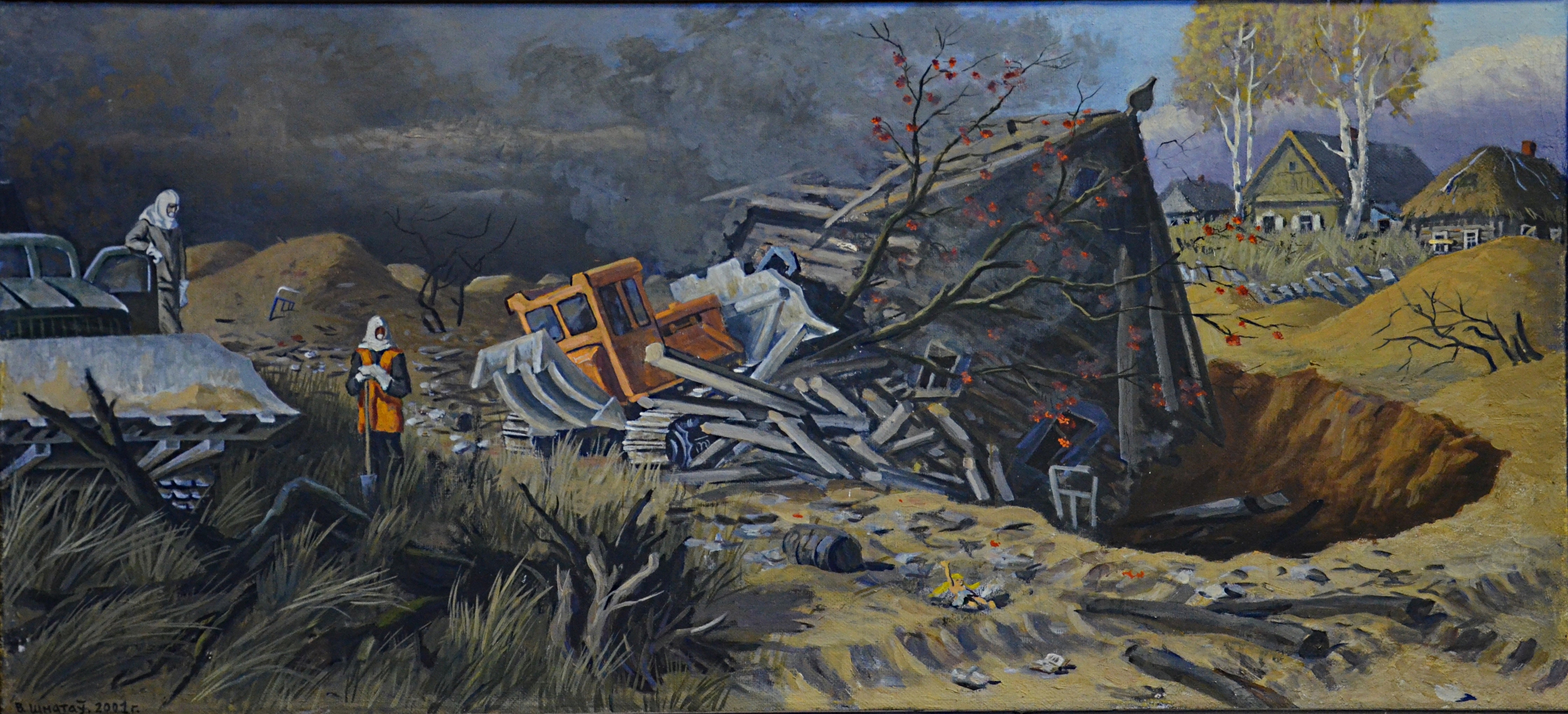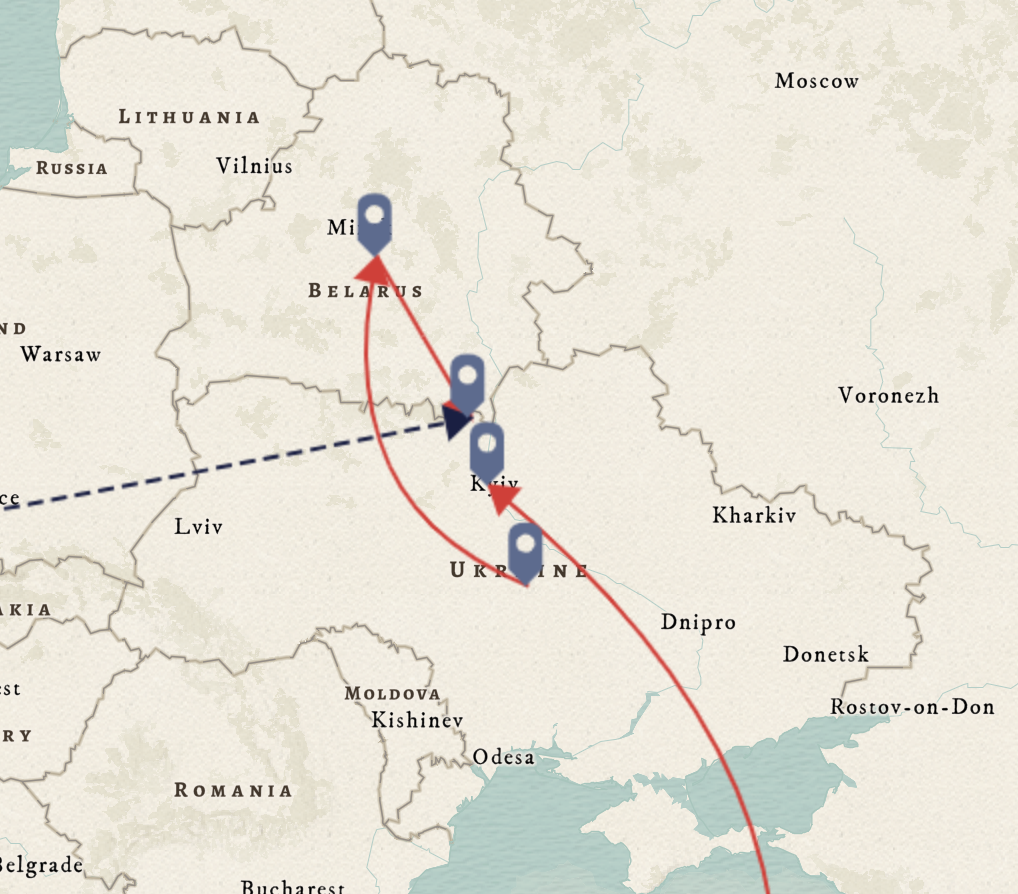The techniques used in paintings reflecting on the Chornobyl disaster reveal extensive information about attempts made after the event to understand and process change. In an examination of artworks focusing on nature it is possible to reveal the connection between the feelings of those living on the land and the impact of disaster on the natural world. These themes allow the examination of the grief and confusion that was attached to the evacuation of the Exclusion Zone and life after the explosion of the reactor. The meshing of both the artist and the natural world is a theme that shows up in many of these works, allowing the viewer to explore each painting of nature as a dissection of the self. The pieces discussed here as well as many other incredible works processing Chornobyl are viewable at https://ecoidea.me/ru/article/1363 and https://art-holst.com.ua/blog/godovshina-chernobilya/.

A major theme in these artworks that exemplifies a mourning of nature and the home is burial, perfectly demonstrated by both Marion Kahnemann’s “Behind the Back of Time”, which includes imagery of trees and dogs entombed under hills, and Victor Shmatov’s Funeral of the Village. In the latter, grief is present in the title alone, and the visuals shows an intertwined house and tree surrounded by rubble being buried with industrial equipment. The metaphor is quite literal (in this and Kahnemann’s work); there is a mourning process taking place for a “home” that has been killed, and the natural world is inseparable from this concept.
In Shmatov’s painting, behind the burial, there is a pristine, sunny neighborhood that observes this bereavement ritual. While the funeral of the home itself is surrounded by darkness and smoke, the nearby houses are brightly lit, splitting the canvas into light and dark and separating the two groups. This distinction made within the painting is artificial, however, and intentionally deceiving. The smoke of the funeral edges towards the light, implying that the other houses will soon face a similar fate. Despite the decrepit and decaying nature of the central house and its contrast with the intact and orderly buildings along the ridge, both areas are similarly dangerous. Radiation is not able to be seen like the concepts of “light” and “dark” are in the painting, and there’s no difference in safety between the two artificially divided zones. Both have witnessed the same disaster and pose the same unseen threat. The false separation is confusing and disconcerting. It causes the viewer to doubt their perception of the area, and their ability to judge what is “safe.”
Safety also concerns Christina Katrakis, and she explores her relationship to her body and radiation in her series of works titled The Zone. The collection is used to process her grief and trauma stemming from her infertility issues caused by the Chornobyl disaster. Included in this set is her triptych entitled Harvest I, Harvest II, and Harvest III. Each image shows a snapshot of the titular harvest. On first glance it appears as though reapers (an icon used throughout this set of works and the wider series) swing scythes through red grass, stripping the color from it as they work. Katrakis explains on her website that it is actually the fur of a beast that she describes as a representation of the apocalypse, something that “swallows all living things,” and a clear stand-in for the disaster and radiation that took so much from her.
The role of nature in Katrakis’ series stands in opposition to the works examined thus far. Instead of nature as a victim, something being grieved alongside humanity, it is the enemy. Simultaneously, though, Katrakis seems to be a part of it. She writes about Harvest II as an eye, where the reapers serve as the beast’s eyelashes, and the pupil is made up of pictures of her as a small child. The pieces that make up this beast are the reapers, Katrakis, and nature (composed of the animal itself and its grass-like fur). The artist complicates the issue of nature’s role within the painting, exemplifying her struggle to find a villain in the disaster and simultaneously working to pin down her own archetype in the narrative. The painting doesn’t give answers; instead it is an exploration of something incredibly amorphous and undefinable.
Georgii Senchenko’s Sakral’nyi peisazh Pitera Breigelia (Sacred Landscape of Pieter Bruegel), presents an image of a post-Chornobyl peasant lifestyle. The painting is modeled after the style of painter Pieter Breugel, a Flemish painter focused on depicting peasant life, among other subjects.1 The forms within Senchenko’s painting mirror that of Breugel’s The Beekeepers but instead shifting the colors, emphasizing the corruption of nature by mimicking the shift in the color of nature within the red forest. Senchenko seeks to provide contrast through his imitation, demonstrating the impact of Chornobyl on what he views as the modern peasant life. The color scheme draws the eye to the backdrop. While the people are central in Breugel’s painting, the focus of Senchenko is on the backdrop, as the leaves have disappeared from the trees. It’s the same warping of the familiar that is so present in every work discussed so far, processed here as a desecration of something “sacred.” The palette is warm, made up of oranges and yellows, which also counters Brugel’s work, which features a grayscale color scheme. In Senchenko, the shadows are painted in green, which adds an unnatural and eerie unfamiliarity to the piece that only enhances the newness within the familiar landscape that it depicts.
Sergei Davidovich’s Chernobyl’skie prizraki (The Ghosts of Chornobyl) is very different from Senchenko’s piece. The painting is centered around nature, and the forest itself blends with human form. No people are in the painting, but the central tree takes on a humanoid shape as it reaches for the sky. The clouds are dark and smoke-like and the oranges and reds of the painting create a subtle allusion to wildfire, contrasting the greens and browns that would be expected in a forest. The trees are rooted to the ground, and although they reach for the sky, seemingly in an attempt to escape, they remain trapped. This unnatural merging of the self and the natural conveys uncertainty once again. It is not people that are supposed to be unable to flee danger. Motion is part of identity, and it is concerning and problematic to consider that despite leaving the Exclusion Zone, radiation remains a part of a person.
The paintings serve as a reflection on a time period in which truth was made relative. Each one relies on similar motifs, warping and shifting something familiar to emphasize danger and strangeness. The combining of warmer, fiery color schemes with smoky imagery implies disaster while leaving the surroundings untouched allows the terrifying and incomprehensible invisibility of radiation to begin to be made sense of. By making their confusion tangible, artists in a post-Chornobyl world attempt to find understanding and clarity through their works, for themselves and those looking for meaning after disaster. In each work, nature, home, and the self are distorted and blended, warping them in a manner that exemplifies this all-encompassing confusion. In these paintings nature serves as a lens through which to look at the destruction and desecration of the self, allowing victims to grapple with the lack of coherence left behind by a disaster of such immense scale.
-
“Pieter Bruegel, the Elder.” Encyclopædia Britannica, Encyclopædia Britannica, inc., 25 Oct. 2023, www.britannica.com/biography/Pieter-Bruegel-the-Elder. ↩
Pascale Lowell ‘26 is a Sophomore at Bryn Mawr College from California. They like to doodle, make stamps and take care of their plants in their free time.
RUSSB220 Chornobyl, Bryn Mawr College, Fall 2023
Licensed under CC BY 4.0.



